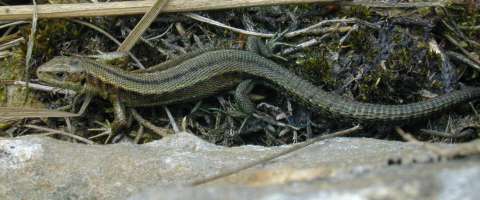
LIZARDS IN THE UK
Three species of lizard occur in the UK. Two of them, the common lizard, and the sand lizard, conform to the classical lizard shape; an animal with an elongated scaly body, four legs, and a long slim tail. The third, the slow worm, has no legs, and closely resembles a snake.
COMMON LIZARD Lacerta (=Zootoca) vivipara

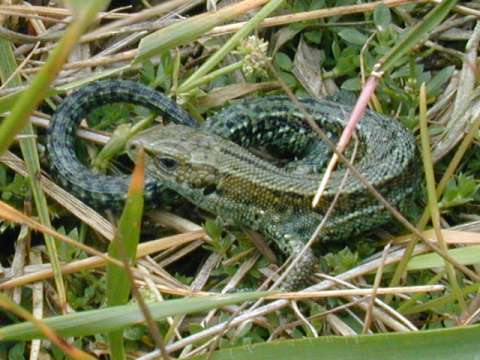
Adult common lizards

Juvenile common lizard
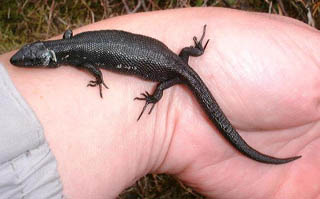
Melanistic female common lizard (photo © Tink Rothwell)
The common, or viviparous lizard, is a small lizard which occurs over much of the UK. They are relatively drab in colouration, being brown, greyish or olive in colour, though they have an orangish underbelly. They may have scattered dark spots, or dark-edged pale spots, and the female will often have thin broken stripes along the back. The colouration is very variable, however the melanistic (black) example pictured above is an extreme variation.
Like all reptiles, the common lizard requires warmth, and often basks in sunny areas. This means that they are most likely to be found in open country, rather than more shady habitats.
This lizard gives birth to live young, hence the term 'viviparous', meaning live-bearing. The young lizards are very dark in colour, and often have light spots on their sides.
The common lizard is relatively fast-moving, and has good vision and hearing, meaning that it is often difficult to observe. Common lizards prey on many small invertebrates.
In the UK, the common lizard can be found in suitable habitat over the whole of mainland Britain and Ireland (where it is the only lizard found), as well as on the Isle of Man, the Isle of Wight, and Anglesey. Outside the UK, Lacerta vivipara has an enormous range, occuring over much of northern and central Europe, extending eastwards to Mongolia, and northwards into the arctic circle.
The sand lizard is somewhat larger than the common lizard, reaching around 9cm body length, with a tail about one and a half times this length. The markings of this species are distinctly different to its drab relative- males may be bright green along their sides, and both sexes have attractive occeli (eye-like markings). The range of the sand lizard in the UK is very restricted. These animals lay eggs, which require some degree of warmth to hatch. Open sandy areas are necessary habitat, where the female lizards can bury their eggs, and where the warmth of the sun provides the heat necessary for successful hatching. Sandy heaths in the south of England, particularly in Dorset, Hampshire and Surrey, and sand dunes in north-west England, house the only surviving populations of this species in the UK.
The sand lizard is a timid species which is difficult to observe in the wild. This, combined with its rarity, means that this beautiful species is rarely seen in the UK. Sand lizards are a highly protected species, but are still at threat from loss of suitable habitat.
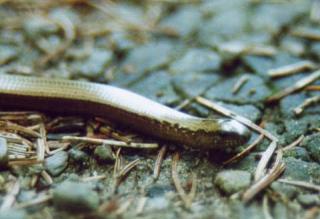

Juvenile and male slow worms
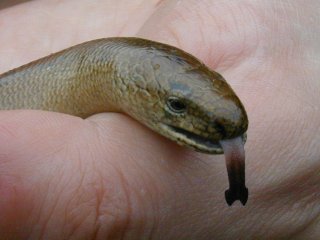
Male slow worm, showing the notched tongue
The slow worm is an animal which looks much more like a snake than a lizard. It has no limbs and a long tail, and is thus often mistaken for a snake. There are a number of differences- like the other two lizards, slow worms have closable eyelids, and a breakable tail. In addition, they have a rather stiffer body than a snake, and move more slowly and jerkily.
Slow worms are usually brown or copper coloured, and are extremely shiny, due to their smooth scales. They usually have some form of stripe down the centre of their back, and females and juveniles in particular have dark sides. Males may have some degree of blue spotting, especially on the head and neck.
Slow worms are burrowing reptiles, and are very secretive. They are most commonly seen under debris, or in compost heaps, although they can sometimes be seen basking like other lizards. Unlike the other two species of lizard, they eat mainly slow-moving food such as slugs and earthworms. This is the reptile species most likely to be found in gardens, especially in compost heaps, where slugs are numerous. Slow worms can be found over all of mainland Britain, and also on the Isle of Wight, Anglesey, and the Hebrides. They generally prefer dry habitats, and their burrowing nature means that they are less dependent on basking areas than the other two lizard species in the UK. Slow worms are possibly the commonest lizard in the UK, and suitable habitats may contain surprisingly high numbers.